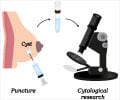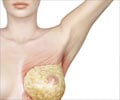Ultrasonography
Ultrasonography lacks the details of a mammogram and is operator dependent.
Ultrasonography (USG) can diagnose if a breast lump is a simple or complex cyst or if it is a solid tumor. The risk of cancer is very low if the lesion is a simple cyst on ultrasound.
During USG, high-frequency sound waves are transmitted which hits the surfaces of the lump and emits echos, which are then, recorded as visual images.
A USG allows clear images to be obtained from any orientation. It helps to locate a tumor and also to guide the probing needle during a cyst aspiration or a biopsy.
However it lacks the details of a mammogram and is unable to pick up micro calcifications (which are one of the first signs of breast cancer), which the mammogram can .
USG also depends on the skill of the sonologist.
Hence USG is used only after a mammogram or a clinical breast examination has already detected an abnormality.
Some experts suggest USG for women below 35 and recommend that the others skip the scan and directly do the FNAC ( Fine Needle Aspiration Cytology).











